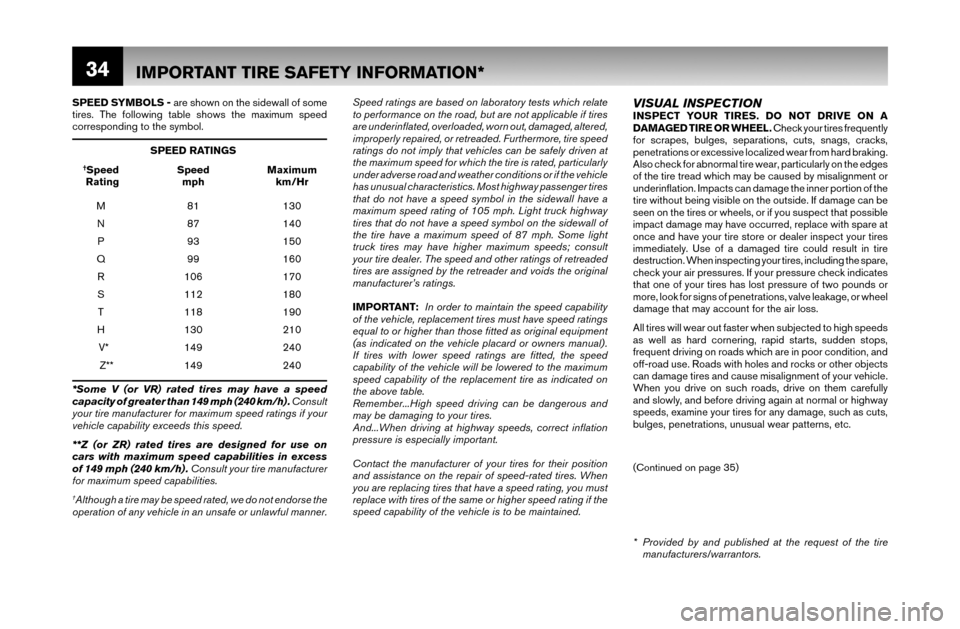stop start NISSAN SENTRA 2007 B16 / 6.G Warranty Booklet
[x] Cancel search | Manufacturer: NISSAN, Model Year: 2007, Model line: SENTRA, Model: NISSAN SENTRA 2007 B16 / 6.GPages: 55, PDF Size: 5.93 MB
Page 37 of 55

34
SPEED SYMBOLS - are shown on the sidewall of some
tires. The following table shows the maximum speed
corresponding to the symbol.
SPEED RATINGS
†Speed Speed Maximum
Rating mph km/Hr
M 81 130
N 87 140
P 93 150
Q 99 160
R 106 170
S 112 180
T 118 190
H 130 210
V* 149 240
Z** 149 240
*Some V (or VR) rated tires may have a speed
capacity of greater than 149 mph (240 km/h) . Consult
your tire manufacturer for maximum speed ratings if your
vehicle capability exceeds this speed.
**Z (or ZR) rated tires are designed for use on
cars with maximum speed capabilities in excess
of 149 mph (240 km/h) . Consult your tire manufacturer
for maximum speed capabilities.
†Although a tire may be speed rated, we do not endorse the
operation of any vehicle in an unsafe or unlawful manner. Speed ratings are based on laboratory tests which relate
to performance on the road, but are not applicable if tires
are underinfl ated, overloaded, worn out, damaged, altered,
improperly repaired, or retreaded. Furthermore, tire speed
ratings do not imply that vehicles can be safely driven at
the maximum speed for which the tire is rated, particularly
under adverse road and weather conditions or if the vehicle
has unusual characteristics. Most highway passenger tires
that do not have a speed symbol in the sidewall have a
maximum speed rating of 105 mph. Light truck highway
tires that do not have a speed symbol on the sidewall of
the tire have a maximum speed of 87 mph. Some light
truck tires may have higher maximum speeds; consult
your tire dealer. The speed and other ratings of retreaded
tires are assigned by the retreader and voids the original
manufacturer’s ratings.
IMPORTANT: In order to maintain the speed capability
of the vehicle, replacement tires must have speed ratings
equal to or higher than those fi tted as original equipment
(as indicated on the vehicle placard or owners manual) .
If tires with lower speed ratings are fi tted, the speed
capability of the vehicle will be lowered to the maximum
speed capability of the replacement tire as indicated on
the above table.
Remember...High speed driving can be dangerous and
may be damaging to your tires.
And...When driving at highway speeds, correct infl ation
pressure is especially important.
Contact the manufacturer of your tires for their position
and assistance on the repair of speed-rated tires. When
you are replacing tires that have a speed rating, you must
replace with tires of the same or higher speed rating if the
speed capability of the vehicle is to be maintained.
VISUAL INSPECTIONINSPECT YOUR TIRES. DO NOT DRIVE ON A
DAMAGED TIRE OR WHEEL. Check your tires frequently
for scrapes, bulges, separations, cuts, snags, cracks,
penetrations or excessive localized wear from hard braking.
Also check for abnormal tire wear, particularly on the edges
of the tire tread which may be caused by misalignment or
underinfl ation. Impacts can damage the inner portion of the
tire without being visible on the outside. If damage can be
seen on the tires or wheels, or if you suspect that possible
impact damage may have occurred, replace with spare at
once and have your tire store or dealer inspect your tires
immediately. Use of a damaged tire could result in tire
destruction. When inspecting your tires, including the spare,
check your air pressures. If your pressure check indicates
that one of your tires has lost pressure of two pounds or
more, look for signs of penetrations, valve leakage, or wheel
damage that may account for the air loss.
All tires will wear out faster when subjected to high speeds
as well as hard cornering, rapid starts, sudden stops,
frequent driving on roads which are in poor condition, and
off-road use. Roads with holes and rocks or other objects
can damage tires and cause misalignment of your vehicle.
When you drive on such roads, drive on them carefully
and slowly, and before driving again at normal or highway
speeds, examine your tires for any damage, such as cuts,
bulges, penetrations, unusual wear patterns, etc.
* Provided by and published at the request of the tire
manufacturers/warrantors.
IMPORTANT TIRE SAFETY INFORMATION*
(Continued on page 35)
57052 Booklet text pages.indd 3457052 Booklet text pages.indd 348/30/06 3:34:27 PM8/30/06 3:34:27 PM